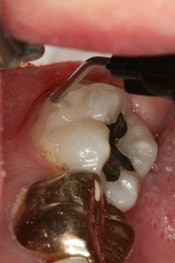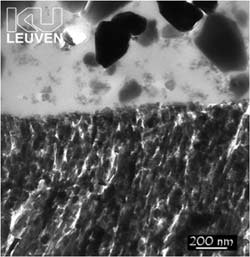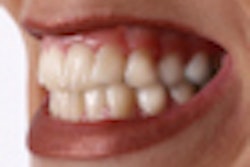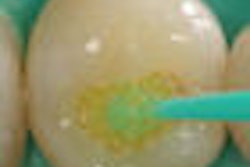
For decades, dental adhesive companies have been squeezing more and more chemistry into fewer and fewer bottles. Now they're down to no bottles at all. That's right: You can apply etchant, primer, adhesive, and restoration all in one step.
So say the makers of two products launched in the past year. And if they're right, this could be the beginning of big changes for the way dentists fix teeth. But how effective are these products?
Researchers at the recent American Association for Dental Research (AADR) meeting in Washington, DC, presented some of the first independent tests of Vertise Flow (Kerr Dental), an unnamed forthcoming Kerr product, and Fusio Liquid Dentin (Pentron Clinical Technologies). They also offered a test of the older Embrace WetBond Class V (Pulpdent), which is being offered for a narrower range of indications and requires an etchant. And they gave preliminary results on a forthcoming self-adhesive flowable from Dentsply Caulk.
No one presented clinical research at the meeting, and the results of the laboratory studies were mixed, but Vertise Flow, at least, held up well in laboratory comparisons with self-etch adhesives.
The products
Of the three on the market, Fusio and Vertise Flow most closely resemble each other. Both are flowable composites. Fusio, launched in May 2009, is marketed for small Class I, III, and V restorations, as a base liner for larger restorations, and as a pit-and-fissure sealant. It's available in Vita shades A1, A2, A3, and B1. The enamel is roughened slightly, then Fusio is applied, agitated, contoured with an explorer, and light-cured.
— Todd Walker, Tufts University
Kerr released Vertise Flow in January 2010, and is marketing it for small Class I and Class II restorations, as a liner for large Class I and Class II restorations, as a pit-and-fissure sealant, and for porcelain repair. It's available in XL, A1, A2, A3, A3.5, B1, B2, Universal Opaque, and Translucent. For small Class I and II cavities, you wash and dry the preparation, brush on the Vertise Flow, cure, and add another layer if needed.
Vertise Flow and Fusio have different chemistry; Vertise Flow uses GPDM (glycerol phosphate dimethacrylate), also found in Kerr's OptiBond adhesives, while Fusio uses 4-META (4-methacryloxyethyl trimellitic acid). They were developed independently, but Kerr's parent, Sybron Dental Specialties, acquired Pentron in 2008, putting them both in the same corporate family.
 |
| Fusio Liquid Dentin is indicated for small Class V cavities. Image courtesy of Pentron. |
How can one company market two products with almost identical indications? Kerr spokeswoman Barbara Young explains that Sybron bought Pentron for its endodontic products (Pentron makes Resilon), so the duplication wasn't intentional. It's keeping the two separate by selling Fusio directly to dental practices, while Vertise Flow is available through distributors.
Embrace Class V, by comparison, is the granddaddy of self-adhesive composite resins, having been on the market since 2002. As the name implies, it's for Class V cavities and other cervical lesions. Etching is recommended, and bonding agents are "optional." Its chemistry involves di-, tri-, and multifunctional acrylate monomers that are hydrophilic and actually require some moisture to be activated. It's available in A2, A3.5, B2, and D2 shades.
The newest addition to this product category comes from Dentsply; researchers at the AADR meeting presented results on a Dentsply flowable product that does not yet have a name and about which few details are available.
The research
So how well did these products do in the tests presented at the AADR meeting? Tufts University researchers compared Fusio and the yet-to-be-released Dentsply product to an all-in-one self-etch adhesive, Dentsply's Xeno IV, in a study supported by Dentsply. They embedded 60 teeth in acrylic resin and ground them with sandpaper.
They next applied the products according to the manufacturer's recommendations. In the case of Xeno IV, that meant attaching a separate composite resin restoration (Tetric EvoCeram, Ivoclar Vivadent). The Dentsply product and Fusio, of course, were adhesive and restoration in one.
 |
| This transmission electron microscopy image shows the adhesion of Vertise Flow to cut enamel. Image by Atsushi Mine and Bart Van Meerbeek. |
After soaking the teeth in water for a day, the researchers tested the restorations' shear bond strength with an Instron 4201 universal testing machine. The Xeno IV clocked in at about 19 megapascals (MPa) on both dentin and enamel, more than twice the strength of the Fusio and Dentsply products on both substrates (p < 0.05). A Tufts experiment using 120 teeth and two different load cell capacities achieved similar results.
The comparison is particularly telling since all-in-one products have often been found weaker than earlier-generation adhesives in which rinsing and priming steps were separate. But these results shouldn't be interpreted as disastrous for the self-adhesive composites, said Todd Walker, a Tufts dental student who presented the first study.
He noted that the type of restoration he tested didn't very closely resemble the restorations that the manufacturers recommend making with these products. None of the self-adhesive products is supposed to accomplish what a large restoration has to do.
"I think instead of shear bond, we should have looked at compressive strength or microleakage," he said.
But the experiment does suggest that dentists should be careful with the new products and not assume they can do what they do with conventional adhesives. "I'm hoping people don't use these flowables where they're not supposed to be used," Walker said.
Vertise Flow fared better in the AADR presentations. In a similarly designed experiment, State University of New York researchers compared Vertise Flow to Filtek Supreme Flow bonded with Prompt L-Pop (3M ESPE) and Tetric EvoFlow bonded with AdheSE-One (Ivoclar Vivadent). They got shear bond strengths of 19-24 MPa on dentin after 24 hours and slightly higher strength on enamel. The study was partly funded by Kerr.
In another experiment funded by Kerr, University of North Carolina at Chapel Hill researchers also got shear bond strengths of about 17-25 MPa. In this experiment, they also tested a more viscous self-adhesive resin product forthcoming from Kerr and found its strength in the same ballpark.
In the only experiment using Embrace Class V, University of Alabama researchers simulated toothbrush wear by mounting specimens in brass cylinders, half-covering them with duct tape, then brushing with a Sonicare toothbrush (Philips) for six hours using toothpaste and a "saliva slurry." Then they removed the duct tape and compared the brushed to the unbrushed surfaces. They found that Embrace was significantly less worn by the brushing than Durafil (Heraeus Kulzer). The study was partly supported by Pentron.
Absent from the AADR studies were presentations on microleakage, dentin permeability, toxicity, and, most important, clinical trials of any kind.
But Kerr and Pentron promise these are on the way. (Kerr has lots of otherwise unpublished data up on its Web site. And Pentron arranged a sneak peak for DrBicuspid.com users at a Dental Advisor clinical study with no control group.)
Pulpdent, meanwhile, appears to be putting more emphasis on its sealants and other products. As for Dentsply, the big news is clearly ahead.
Copyright © 2010 DrBicuspid.com



















